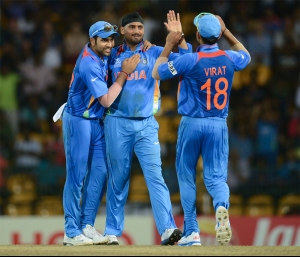
Three days can be too long in cricket and England realised it the hard way.
Only on Friday, England were brimming with pride and confidence after annihilating Afghanistan by 116 runs. On the other hand, India had come in for all-round criticism, and justifiably so, for their scratchy win against their Asian greenhorns.
England appeared ready to teach India a lesson or two in T20 cricket, but it was instead MS Dhoni and company who handed a crushing 90-run defeat to the defending champions in their final Group ‘A’ match here at the packed R Premadasa Stadium on Sunday night.
After posting a competitive 170/4 on the back of knocks from Rohit Sharma (55 n.o., 33b, 5x4, 1x6), Virat Kohli (40, 32b, 6x4) and Gautam Gambhir (45, 38b, 5x4), Indian spinners played havoc with the clueless English batsmen to bowl them out for a paltry 80 in 14.4 overs to qualify for the Super Eight stage as group toppers.
Harbhajan Singh (4-12), returning to the squad after being in the wilderness for over 12 months, bamboozled the Englishmen with his bag of tricks in his parsimonious four overs.
With an equally impressive Piyush Chawla, again playing his first international since the match against the Netherlands in March 2011 in the World Cup, claiming 2-13 with his assortment of googlies and leg-breaks, England looked like the Afghanistan of Friday.
Two slips, a short-leg and a silly point are a rare sight in T20 cricket where captains would prefer to dot the boundary line with fielders. But such was the effect of Indian spinners that Dhoni was forced to pack his close-in cordon in anticipation of wickets that fell like nine-pins.
Redemption
It was a sort of redemption for man of the match Harbhajan, who last played his match against England in the Nottingham Test last year before being ignored for his patchy form. Irfan Pathan (2-17), too, played his hand in India’s victory, dismissing opener Alex Hales and the dangerous Luke Wright cheaply. It was also a vindication of five-bowler strategy adopted by India, who until this match were reluctant to play with a batsman less. India, meanwhile, rested Zaheer Khan and R Ashwin along with Virender Sehwag.
Barring the six-over Power Play period and the final five overs, Indian innings chugged along a trifle slow in the middle overs.
After losing make-shift opener Irfan, who stepped in for Sehwag, early in the innings, Kohli provided the momentum with some crunching drives. With Gambhir picking up the odd boundary, India raced to 52 during field restrictions. It was as good a start as India would have hoped for after being asked to bat first by England who included an extra seamer in Tim Bresnan dropping Samit Patel.
On hindsight England might be regretting their decision to play with just one spinner -- Graeme Swann.
The way Indian spinners left the English batsmen befuddled and the manner in which the England off-spinner kept the Indian batsmen quiet, the left-arm spin of Patel may have come in handy. Swann, introduced immediately after the Power Play, bowled with great control and precision as Kohli and Gambhir failed to force the pace against the wily bowler.
Kohli perished, trying to send Swann out of the park. A tired-looking Gambhir was unable to make much headway though the knock would have done a world of good to his confidence. In an effort to get some quick runs, Gambhir holed out in the deep that heralded the best phase for the Indian innings.
Rohit took an erratic English attack apart as India collected 57 runs in the last five overs. The frenetic pace of run-making also forced the English fielders into silly errors that helped India post a good total which eventually proved quite daunting.
Score Board
INDIA
Gambhir c Kieswetter b Finn 45
(38b, 5x4)
Irfan b Finn 8
(8b, 1x4)
Kohli c Bairstow b Swann 40
(32b, 6x4)
Rohit (not out) 55
(33b, 5x4, 1x6)
Dhoni c Hales b Dernbach 9
(8b, 1x4)
Raina (not out) 1
(1b)
Extras (B-1, LB-3, W-8) 12
Total (for 4 wkts, 20 overs) 170
Fall of wickets: 1-24 (Irfan), 2-81 (Kohli), 3-119 (Gambhir), 4-166 (Dhoni).
Bowling: Finn 4-0-33-2 (w-3), Dernbach 4-0-45-1 (w-3), Broad 4-0-36-0, Bresnan 4-0-35-0 (w-1), Swann 4-0-17-1 (w-1).
Runs during Power Play: 1-6 overs: 52/1.
ENGLAND
Kieswetter c Kohli b Chawla 35
(25b, 4x4, 2x6)
Hales b Irfan 0
(2b)
Wright lbw Irfan 6
(4b, 1x6)
Morgan b Harbhajan 2
(6b)
Bairstow b Chawla 1
(8b)
Buttler b Harbhajan 11
(12b, 1x4)
Bresnan c Gambhir b Harbhajan 1
(8b)
Broad c Gambhir b Dinda 3
(3b)
Swann st Dhoni b Harbhajan 0
(3b)
Finn (not out) 8
(10b, 1x4)
Dernbach (run out) 12
(7b, 2x4)
Extras (W-1) 1
Total (all out, 14.4 overs) 80
Fall of wickets: 1-2 (Hales), 2-18 (Wright), 3-39 (Morgan), 4-42 (Bairstow), 5-51 (Kieswetter), 6-54 (Bresnan), 7-60 (Buttler), 8-60 (Swann), 9-60 (Broad).
Bowling: Irfan 3-0-17-2 (w-1), Balaji 1-0-10-0, Dinda 2-0-26-1, Harbhajan 4-2-12-4, Chawla 4-1-13-2, Yuvraj 0.4-0-2-0.
Runs during Power Play: 1-6 overs: 39/3.





Comments
Add new comment